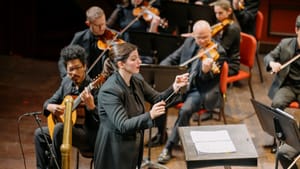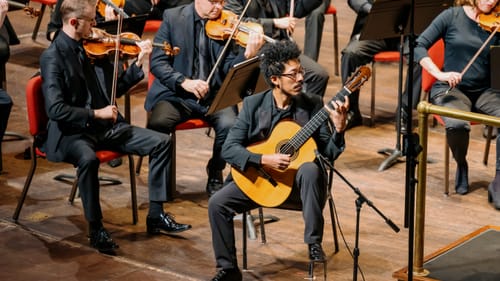Stay in the Loop
BSR publishes on a weekly schedule, with an email newsletter every Wednesday and Thursday morning. There’s no paywall, and subscribing is always free.
DSO goes around the world
The Delaware Symphony Orchestra presents ¡Música Bravo!

On Friday, November 10, the Delaware Symphony (DSO) welcomed guest conductor Michelle Di Russo, who offered ¡Música Bravo!, a sparkling, accomplished concert. DSO chief executive J.C. Barker had told Di Russo to “program your ideal concert,” and so the evening featured works from Mexico, Argentina (her home), and Spain, capped with a Russian tribute to Spanish music.
The concert opened with the vibrant Danzón No. 2 by Arturo Márquez (b. 1950). Inspired by a Cuban dance form with which Márquez became fascinated, this newest piece on the program premiered in 1994 in Mexico City. Exuberant and sensuous, it features a bluesy piano riff, cushiony string writing, and a flashy trumpet solo. The work opens with an extended clarinet solo that returns later, capping an intricate and joyous opener.
Next was Estancia: Four Dances by Alberto Ginastera (1916-1983). Speaking from the podium, Di Russo noted that this 1943 work from her home country was very different from the Márquez: “rougher, melancholic, full of passion, reminiscent of tango.” A programmatic work in four titled movements, it opens with Los trabajadores agricolas (the land Workers), filled with a mechanistic, industrial mid-20th-century pulse. Danza del trigo (wheat dance) is an extended waltz with sweeping lines and evocative flute passages. Los peones de hacienda (the cattlemen) features charging rhythms and descriptive writing for the lower instruments. And the piece concludes with Danza final (final dance), an energetic movement with percussive episodes and a series of exciting xylophone glissandos.
A rapturous Concierto
The program’s centerpiece was the exceptional Concierto de Aranjuez by Joaquín Rodrigo (1901-1999), the Spanish composer who captured the soul of his country. Rodrigo describes his composition (named after a royal site on the River Tagus) as “the essence of an 18th-century court ... where some perceive ... the singing of birds and the gushing of fountains.” It’s an apt description of this three-movement work, perfectly chosen to showcase the elegant virtuosity of featured soloist Brazilian guitarist João Luiz. Luiz is no stranger to the DSO; in 2018, he and partner Douglas Lora, the Brasil Guitar Duo, joined the orchestra in a NAXOS premiere recording of concerti by Paulo Bellinati and Leo Brouwer.
Rodrigo’s much-loved 1940 Concierto opens with a beautiful allegro con spirito, orchestra forces reduced to match the guitar’s intimacy. The work is one of finesse and elegance, also a hallmark of Luiz’s artistry, and here Di Russo created an almost magically different atmosphere. The well-known second adagio movement mesmerized a hushed audience with its continual dialogue between the guitar and orchestra, as the conductor sensitively foregrounded each solo guitar section. Luiz played an extended cadenza of exceptional grace, after which the orchestra made a majestic entrance. Notably, this movement was arranged by jazz great Miles Davis for his Sketches of Spain.

Even with reduced forces, an orchestra is still a substantial organism, fronted here by one of music’s most intimate of instruments, the guitar. But Luiz’s microphone was effective, and Di Russo guided the orchestra with great subtlety, so there was none of the “now it’s my turn, now it’s yours” that can mar the delicate beauty of Rodrigo’s work. The final allegro gentile movement is another dialogue between guitar and orchestra, with fugue-like theme-and-development sections leading to a rapturous conclusion that left the audience cheering, calling back soloist and conductor for multiple bows, and Luiz returned for a short encore.
de Falla and Rimsky-Korsakov
After intermission, two intense and powerful works changed the concert’s tone. Manuel de Falla (1876- 1946), one of Spain’s most influential composers, wrote El amor brujo (1915) as a theater-and-ballet piece. When that iteration found little success, he revised it as the orchestral suite heard here. The programmatic five-section work—telling a ghostly tale of lost love—is filled with haunting music, especially its famous finale, “Ritual Fire Dance.”
The evening ended with Capriccio Espagnol by Nikolai Rimsky-Korsakov (1844-1908). This oldest work on the program (it premiered in 1887) is filled with masterful orchestral writing and the work, an emotional Russian view of Spanish music, showcases the entire ensemble. The composer originally conceived it as a concerto for violin and orchestra, accounting for the prominent and remarkable writing for strings. Throughout, there are virtuoso cadenzas for the orchestra’s instruments (including concertmaster David Southorn), which the DSO players realized with artistry, and Di Russo called out a bevy of soloists for individual bows at the end, also garnering her own well-earned ovation.
An orchestral treasure
The concert’s printed program was also offered in Spanish, and it now matches each composition with an informative list of parallel events in music, literature, and art, and global, US, and Delaware history, placing the works in a broader context rather than musical isolation.
This season, the DSO welcomes a series of guest conductors, with music director laureate David Amado on the podium for opening and closing concerts. At the entrance was a placard reminding attendees of Amado’s 20-year tenure building this orchestra, something Maestra Di Russo tacitly acknowledged in her opening remarks. Clearly delighted to be working with the DSO, she called them “a treasure” and told the audience that “you should be very proud of your musicians.” And evidenced by frequent extended ovations and shouts of bravo for this well-titled and impeccably conducted concert, it was clear that they are.
What, When, Where
¡Musica Bravo! Arturo Márquez, Danzón No. 2; Alberto Ginastera, Estancia: Four Dances; Joaquín Rodrigo, Concierto de Aranjuez; Manuel de Falla, Suite from El amor brujo; and Nikolai Rimsky-Korsakov Capriccio Espagnol, Op. 34. Conducted by Michelle Di Russo. The Delaware Symphony Orchestra. November 10, 2023, at the Grand Opera House's Copeland Hall, Wilmington; and November 13, Cape Henlopen High School, Lewes. (302) 656-7442 or delawaresymphonyorchestra.org.
Accessibility
The Grand’s Copeland Hall is wheelchair accessible, and assistive listening devices are available.
Masks were not required.
Sign up for our newsletter
All of the week's new articles, all in one place. Sign up for the free weekly BSR newsletters, and don't miss a conversation.
 Gail Obenreder
Gail Obenreder